A wonder of the ancient world, the Colossus was constructed out of a single slab of marble and erected over the harbor in the island of Rhodes. Alas, as all things mighty must tumble, Colossus eventually shattered–after weary centuries standing sentry-into six pieces which sunk into the ocean.
We all know that the floor of the Aegean is violent and temperamental: in its currents, the six fragments took on new forms–the sea washing away old features and granting new ones. Colossus’s head was no longer just a head, but an entire being; the Colossus’s arms appeared to grow bodies and heads of their own.
Then a truly remarkable thing happened. One autumn afternoon, Poseidon was riding in his chariot (the one driven by sea horses) when he saw the six fragments, each now a complete and individual statue. “What a great tragedy,” he said to nobody in particular, “to leave these wondrous statues on the ocean floor to fall into decay.” He raised them out of the water and lay them softly on the shore, giving each of the fragments life and special powers.
Yet the gods do not grant favors lightly.
The six Mini-Colossoi are slaves to the power of the lord Poseidon, and must do his bidding. He commands us to rock unsuspecting youth in your bars and houses, drinking your beer and crushing your skulls with thundering beats, baroque polyphony, galloping basses, and soaring vocals–all of which testify to the awesome power of mighty Poseidon.



